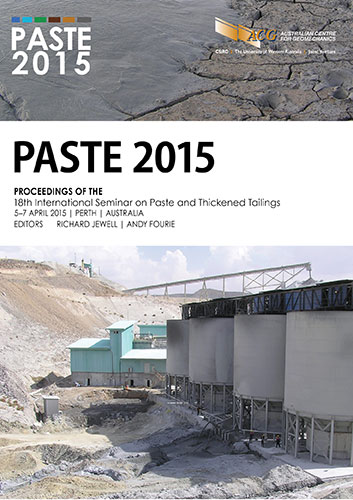Series connection of diaphragm piston pumps

|
Authors: Nägel, DM; Gänsl, R Paper is not available for download Contact Us |
DOI https://doi.org/10.36487/ACG_rep/1504_18_Gansl
Cite As:
Nägel, DM & Gänsl, R 2015, 'Series connection of diaphragm piston pumps', in R Jewell & AB Fourie (eds), Paste 2015: Proceedings of the 18th International Seminar on Paste and Thickened Tailings, Australian Centre for Geomechanics, Perth, pp. 257-266, https://doi.org/10.36487/ACG_rep/1504_18_Gansl
Abstract:
Pipeline transportation of ore concentrates (copper, nickel, iron, etc.) at high solids concentration can be a cost-efficient, safe, eco-friendly and particularly emission-free alternative to conventional systems utilising conveyor belts, trucks and trains. So far, available pumping systems are typically allowed for slurry pipelines of up to 300 km distances only. The connection of several pumps of identical size allows for higher flow rates or pressures. With parallel operation, the collective flow rate is combined at identical delivery head pressure. In series operation, however, delivery head pressure is combined, whilst the flow rate from each pump is identical (Figure 1). Both parallel and series options are practicable, but series connection is not that common for positive displacement pumps as their maximum operating pressure is already high. With piston pumps, a fixed volume is displaced with every stroke, almost independent of the operating pressure. Calculation of the theoretical flow is based on the number of pistons and stroke rate per minute. Leakage and elasticities reduce the hydraulic efficiency and decrease the actual flow. Friction losses depend on the flow rate, whilst constant resistance results from the differential head component. The formula to calculate pipe resistance for constant flow is as follows: Normally soft gas cushioned air vessels are employed for pulsation dampening. Thus, other elasticities are negligible. If diaphragm piston pumps are used as the pipeline pump, then the formula p = f(Q) is applicable. Pumps are conventionally connected in series and open reservoirs are required at the suction side of each pump to compensate for differential flow rates. This results in an efficiency loss of >10% for the complete system. Flow adjustment is required for closed serial connection, in order to avoid changes in pipe volume and limit influence on the pump pressure. Therefore, flow rate differential of pumps operating in series must be small and adaptable. Latest measuring and control technology allows for serial connection of displacement pumps in a closed system. Flow control is possible by variation of stroke rate, or length, or by use of a bypass system. The first two options are favourable energy-wise, as they directly influence the theoretical displacement volume. Stroke control is most often used for metering pumps. Speed control ensures energy-efficient adjustment of the flow rate and is commonly applied on larger pumps. Series connection of diaphragm piston pumps in a closed system requires special control. Speed variation of the first pump requires adaptation of the remaining pumps, in order to maintain an identical volume flow from all pumps. Over a longer time, even small measuring inaccuracies result in considerable deviation of the integral and conveyed volume. Flow adjustment is based on pressure measurement. Volume changes in individual pipe sections affect the pressure level. Falling below the suction constraints, or exceeding the discharge limit, requires reduction of the flow rate. Communication between individual pump stations is essential in terms of equipment safety and stability of the control loop. Closed systems incorporating diaphragm piston pumps connected in series allows for the realisation of energy-efficient pipeline systems with distances in excess of 300 km.
References:
Nägel, HM 2010, Hermetically sealed displacement pumps – the evolution of pump technology: from piston and diaphragm pumps to the MULTISAFE double hose-diaphragm process pump, FELUWA Pumpen GmbH, Mürlenbach.
Wilson, KC, Addie, GR & Clift, R 1992, Slurry transport using centrifugal pumps, Springer, London.
© Copyright 2025, Australian Centre for Geomechanics (ACG), The University of Western Australia. All rights reserved.
View copyright/legal information
Please direct any queries or error reports to repository-acg@uwa.edu.au
View copyright/legal information
Please direct any queries or error reports to repository-acg@uwa.edu.au